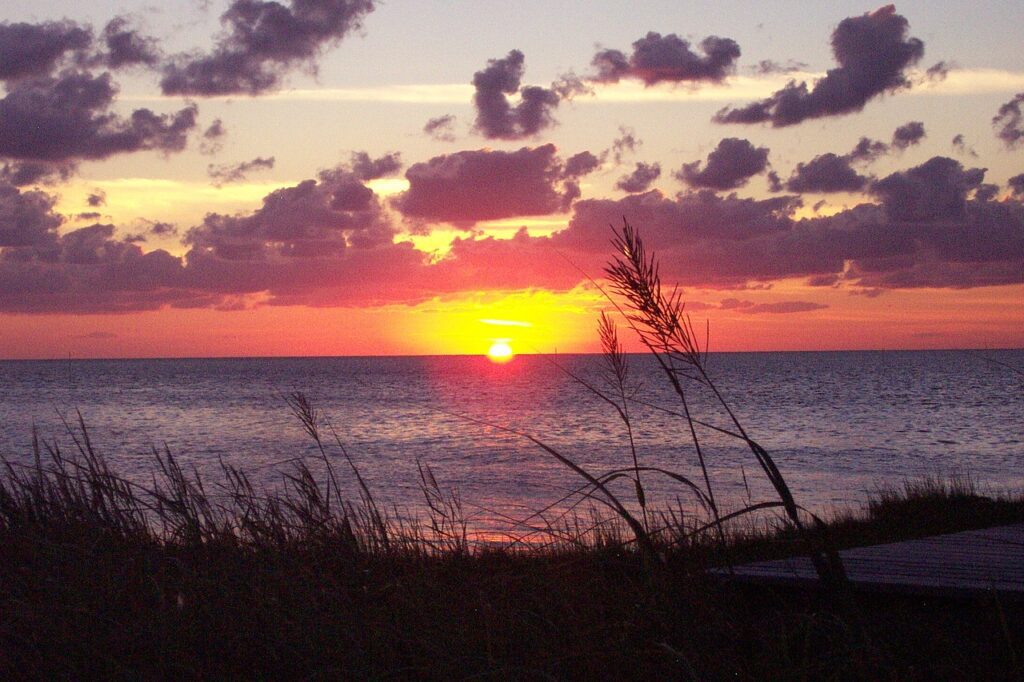North Carolina is home to the beautiful Blue Ridge Mountains and coastal Outer Banks and stretches out between these two landscapes for hundreds of miles. As you can imagine, the North Carolina annual weather can vary from season to season and from diverse locations.
North Carolina generally experiences milder seasons, but harsher winters and hotter summers can happen periodically. Humidity during the summer is typical for Southern states, meaning it is thicker on average than others. North Carolina annual weather is generally mild year-round and suitable for all sorts of activities, using just a few simple tips.
Knowing North Carolina annual weather patterns before planning adventures is essential for making the most of your stay here! It will allow you to make the most out of every experience and maximize the potential of this beautiful state.
NC Climate Outlook in Brief

North Carolina lies within the southeastern region of the US and is known for its varied topography and climate, which in turn contribute to its diverse weather patterns.
North Carolina experiences humid subtropical weather with hot and humid summers and cool winters influenced heavily by proximity to the Atlantic Ocean and the Appalachian Mountains; their combination creates a unique weather pattern characterized by distinct seasons and occasional extreme events.
Statewide climate can be divided into three distinct regions in North Carolina: coastal plain, Piedmont, and mountains. Of the three, coastal plain residents typically enjoy milder winters and hotter summers than their counterparts; Piedmont city dwellers in Charlotte and Raleigh tend to experience slightly cooler winters while warmer summers than elsewhere, whereas mountains experience cooler year-round temperatures due to higher elevation.
North Carolina’s climate is heavily impacted by the Gulf Stream, an ocean current spanning from Canada down through Florida and into North Carolina. It brings warm air and moisture that helps contribute to humid conditions across its eastern coastline. When combined with topographic factors and the geography of its state, such humidity often results in thunderstorms forming that bring heavy precipitation.
North Carolina’s climate can best be described as variable and diverse, providing residents and visitors with various weather conditions throughout the year.
North Carolina annual weather trends
North Carolina experiences four distinct seasons – Spring, summer, fall, and winter – each offering different weather patterns and activities. Let’s look at what awaits us during each one in North Carolina.
North Carolina annual weather during the Spring
Spring in North Carolina is a picturesque time of year as temperatures slowly warm after the winter. By March, temperatures begin to increase, and colors come alive as flowers bloom across the state – April and May are peak months for this stunning transformation, featuring vibrant azaleas, dogwoods, and cherry blossoms, all adding their distinctive beauty to our state landscapes.
North Carolina enjoys mild temperatures during Spring, with highs ranging from the upper 60s to low 80s Fahrenheit (15 to 27 degrees Celsius). Although temperatures fluctuate widely depending on rainfall or thunderstorms, Spring remains an ideal season to visit North Carolina, particularly for outdoor enthusiasts who love fishing, hiking, and exploring its natural wonders.
North Carolina Annual Weather in the Summertime
North Carolina summers feature hot and humid conditions, often reaching 90s Fahrenheit (32 degrees Celsius). Humidity can run high during the summer, so remember to dress appropriately, stay dehydrated, and plan activities accordingly.
North Carolina’s summer months – June to August – offer the ideal opportunity to visit its incredible coast and beaches. Visitors to the Outer Banks or Wilmington beaches can soak up some sun, swim in Atlantic Ocean waters or engage in various watersport activities while experiencing refreshing sea breezes, which provide respite from heat waves.
The Piedmont region provides numerous outdoor activities, from hiking and camping trips to exploring parks and forests. Keep in mind, however, the heat! Prepare with sunscreen, lightweight clothing, and hydration to stay comfortable.
Fall in North Carolina

Fall in North Carolina is an enjoyable season for residents and visitors alike, starting in September when temperatures generally dip into the 60s to 70s Fahrenheit (15 to 25 degrees Celsius). As autumn continues, outdoor activities become even more enjoyable!
North Carolina’s fall foliage display is one of its signature attractions, delighting viewers from near and far with breathtaking displays of red, orange, and yellow colors across various tree species such as maples, oaks, and hickories. The Blue Ridge Mountains offer some of the best attractions for hikers, scenic drives, and photographers. Peak foliage generally occurs around October.
Fall brings milder temperatures and is the ideal season for exploring North Carolina’s charming towns and cities, visiting historical sites, attending fall festivals, and enjoying crisp air in its cozy environment. North Carolinians love this season!
Winter in North Carolina
Winter in North Carolina tends to be relatively mild compared to other states across America, especially along the coastal and Piedmont regions. On the contrary, mountainous areas of western North Carolina experience lower temperatures, with snowfall becoming common, making these mountainous regions popular winter sports spots.
Temperatures during the winter in coastal and Piedmont regions usually fall between 40-50 F (4-10 C), making snow uncommon; however, occasional winter storms may bring light dustings of snow or freezing rain that quickly melt away.
Though winter temperatures tend to be milder in North Carolina than in other seasons, winter remains an attractive time to travel and discover its treasures. Hikers or nature trail enthusiasts will benefit greatly from clear visibility when hiking nature trails. Winter offers unique opportunities for holiday festivities, visiting Christmas tree farms and cozying up by fireplaces in charming mountain cabins.
North Carolina Can Experience Extreme Weather Events
Like many southeastern US states, North Carolina can experience extreme weather events like hurricanes, tornadoes, and thunderstorms.
North Carolina’s location along the Atlantic coastline places it at risk from hurricanes during Atlantic hurricane season, typically from June 1-Nov 30th each year. These events, however, are rare.
Tornadoes
Tornadoes are another weather event that can happen but are rare in North Carolina.
North Carolina experiences approximately 30 to 40 tornadoes annually, with most occurring in its central and eastern portions. While tornadoes may be unpredictable, it’s vitally important that individuals have a plan in place and seek shelter when severe weather warnings are issued. Again, I offer this info as a PSA, but these events are rare.
North Carolina experiences severe thunderstorms frequently throughout the spring and summer months. These powerful storms feature strong winds, heavy rainfall, lightning strike(s), hailstones or sometimes hail, localized flooding, and power outages, often developing quickly with localized flooding issues and power interruption.
Staying aware of severe weather warnings is crucial, and having a plan in place should one be issued is also vital to keeping yourself and others safe when necessary. Paying close attention to local forecasts and having reliable sources such as a weather radio or smartphone app installed to receive updates regarding thunderstorm warnings is highly advised.
How Weather Affects Tourism in North Carolina

North Carolina’s varied climate and weather patterns play a pivotal role in its tourism industry, providing visitors with activities and attractions they can experience throughout their stay in North Carolina.
Every summer, North Carolina coastal regions draw visitors from across the nation who experience its beautiful beaches and enjoy watersports activities. Its warm temperatures and refreshing sea breezes provide the ideal setting for a perfect beach vacation experience.
North Carolina draws visitors each autumn with its vibrant foliage and pleasant temperatures, creating stunning fall colors to explore during hiking trips, scenic drives, and outdoor festivals. Many tourists travel here specifically to view Asheville’s Biltmore Estate as it bathes in autumn foliage.
Winter tourism in North Carolina centers around its mountainous regions, where visitors can enjoy skiing, snowboarding, and other winter sports activities. Colder temperatures and occasional snowfall provide ideal conditions for an idyllic winter escape.
Visitors to North Carolina in the Spring flock here, eager to witness blooming flowers and join in outdoor activities such as hiking, fishing, and birdwatching. Mild temperatures and vibrant landscapes provide a wonderful setting to discover North Carolina’s natural splendor.
Best Times and Seasons to Travel North Carolina Based on Weather
Your ideal time and place for visiting North Carolina depend entirely upon personal preference and activities you want to do there, with excellent times depending on weather conditions being as follows:
Summer: North Carolina offers ideal coastal regions for beach vacationers or watersport enthusiasts seeking warm temperatures and plenty of sunshine. Be prepared for crowds when visiting popular beach destinations!
Fall: North Carolina provides breathtaking fall foliage scenes throughout September, October, and November, with mild temperatures allowing landscapes to burst with vibrant hues – the ideal weather conditions to hike, camp out, or attend fall festivals!
Winter: For snow sports enthusiasts or cozy cabin getaways in the mountains, winter in North Carolina offers ideal conditions. Colder temperatures and the occasional snowfall create ideal conditions for skiing, snowboarding, and other winter-specific activities like skating.
Spring: North Carolina in Spring offers ideal conditions for outdoor enthusiasts such as hiking, fishing, and exploring nature. Temperatures remain mild while blossoming flowers bring color and landscapes come alive across the state – be ready for occasional showers and thunderstorms, though!

North Carolina Weather-Related Activities
North Carolina offers residents and visitors abundant weather-related experiences and activities they can participate in here, from golf to cycling to surfing and beyond. Here are a few activities related to North Carolina annual weather to take advantage of:
North Carolina features an expansive coastline that features numerous stunning beaches for you to discover, from Outer Banks to Emerald Isle. Enjoy basking under the sun while swimming in the ocean or participating in water activities such as kayaking, surfing, and fishing!
Hiking and Camping: North Carolina boasts numerous national parks, state parks, and forests, offering opportunities for hiking, camping, and exploring the great outdoors. From Appalachian Trail to the Great Smoky Mountains National Park, there is something here for every skill level, and breathtaking vistas await discovery!
Fall Foliage Tours: Experience North Carolina’s vibrant autumn leaves at their most spectacular by driving or visiting the Blue Ridge Parkway to take in all their splendid hues or visiting Biltmore Estate and see for yourself! Don’t forget your camera if this activity interests you – and don’t forget any photo ops along your trip!
Winter sports: If you’re visiting North Carolina during wintertime, why not hit the slopes? Mountainous regions boast ski resorts and winter sports activities suited for novice and expert riders – providing an exhilarating and memorable experience to newcomers and experienced riders alike.
Storm Chasing: For adventure seekers, experiencing thunderstorms or lightning strikes can be a thrilling experience. Just ensure that when viewing severe weather, you take proper safety precautions.
Visit historical sites and museums: No matter the weather, North Carolina boasts numerous historical sites, museums, and art galleries that promise an enjoyable visit no matter the circumstances – from Wright Brothers National Memorial to the North Carolina Museum of Natural Sciences, there’s sure to be something comforting in store!
North Carolina boasts abundant activities and experiences suitable to any weather or interest; its diversity caters to diverse interests and preferences.
North Carolina’s annual weather is an intriguing combination of climates and conditions that shape its landscapes and offer visitors and residents unique experiences every season. Each season, from sandy beaches to picturesque mountains, brings something new for residents to appreciate and activities to participate in.
Understanding North Carolina’s weather patterns is integral for planning an optimal trip and taking full advantage of your stay here. North Carolina provides something special, from beach vacations and winter retreats to fall foliage and autumnal tours.
Staying aware of weather forecasts, particularly during severe events, and being ready for occasional rain showers and thunderstorms will enable you to create lasting memories in North Carolina’s ever-evolving climate.

